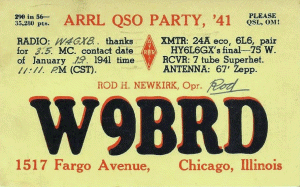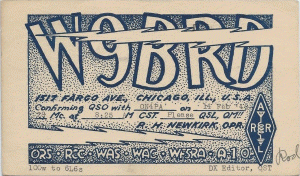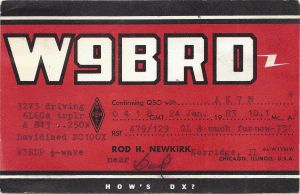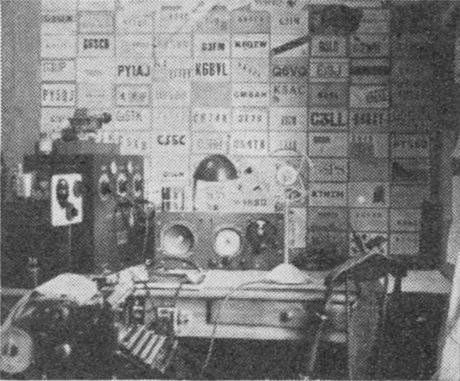






|

|

|

|

|

|
The amateur radio call sign W9BRD has been assigned to—held by, as ham radio operators like to put it—at least four people (see "A Brief Early History of the W9BRD Call Sign," below), of whom I am the fourth. My father, Rod Newkirk (1922–2012 CE) was the third, and since June 24, 2014 CE—when I began operating W9BRD IV—I have been enjoying my amateur radio in celebration of him and what I reverently refer to as The Rogers Park Triangle of Radio Friends: Rod Newkirk, W9BRD; Phil Simmons, W9VES; and George ["Bud"] Nibbe, W9NUF. By mid-2014 CE, when this page was first created, the expanding sphere of Effect created by the first W9BRD III transmission spanned a diameter of nearly 154 light-years.
W9BRD Then and Now
The first transmitter used by my father as W9BRD III was a 6L6 oscillator and two crystals. By 1940–1941, transmitting at W9BRD was handled by a kit-built Utah UAT-1 (Figure 1).
 |
| Figure 1—Amateur radio station W9BRD III of 1940–1941 CE. The transmitter (black box at left, with three identical dials in a row) was a Utah UAT-1; the receiver was a multiband Sears Silvertone broadcast receiver repackaged and modified to include a beat-frequency oscillator (BFO) for Morse code reception. This photograph was published in J. A. Moskey, W1JMY, "Eleventh ARRL Sweepstakes Results," QST, June 1941, pages 49–54 and even-numbered pages from 82-90 and 94-104, inclusive. In that November 1940 operating contest, W9BRD won in Illinois for radiotelegraph with 586 contacts in 61 ARRL sections. A table detailing the equipment and frequency bands used by section winners described the W9BRD plant as follows: transmitter lineup, 24A-6L6-HY6L6GXes; type of oscillator, e.c.o (electron-coupled oscillator, a synonym for variable-frequency oscillator [VFO]); receiver, 7-tube superheterodyne; bands used, 3.5, 7, and 14 Mc. The UAT-1 would have operated with an RF power output on the order of 50 to 60 watts. The antenna was a 40-meter Zepp—a 66-foot-ish wire end-fed with 33ish feet of open-wire transmission line. |
The first transmitter I used at W9BRD IV was the W9VES-W9BRD Changeover Transmitter (a single-tube tuned-plate, crystal-grid oscillator using a 47 [in W9VES mode] or metal 6L6 [W9BRD]). Nowadays amateur radio station W9BRD IV commonly runs 5 to 25 W output at 40 and 80 meters (the 7- and 3.5-MHz amateur radio bands). My favorite operating frequencies at 40 meters are 7.12 MHz and vicinity, secondarily 7.05 MHz and vicinity; at 80 meters, 3.54 to 3.6 MHz and vicinity. The W9BRD IV antenna is currently a 104-foot doublet, 25ish feet up, fed with window line via a balanced antenna tuner. The transmitting and receiving equipment used is usually homemade but may include classic commercially built equipment during particular operating events.
A W9BRD Affiliation Mystery Solved
My father's pre-World-War-Two QSL cards include the usual list of affiliations: ORS (Official Relay Station), RCC (Rag Chewer's Club), WAC (Worked All Continents), A-1 Op (A-1 Operator's Club). One affiliation, WFSRA, remained mysterious. A clue in the correspondence column in March 1938 QST pointed me to an "I. A. R. U. News" item on page 74 of July 1935 QST, and I had my answer:
W.F.S.R.A.:
The World Friendship Society of Radio Amateurs has requested publication of the following pledge, which is the sole obligation for membership in the Society:
"I hereby promise that I will, to the best of my ability, make such use of my amateur radio station as will be conducive to international friendships; that I will never voluntarily permit by station to be used as the tool of selfish nationalistic interests; and that I will do what I can, as a radio amateur and as an individual, to promote world peace and understanding. (To be followed by the signature, address and station call.)"
Membership in the Society is open to all amateurs in all countries. All that is necessary to become a member is to copy and sign the pledge, and send it to the secretary, Duane Magill, W9DQD, 730 N. 6th St, Grand Junction, Colorado, U.S.A. Copies are preferably to be made in English or French, but may be made in the language of the member."
A Year with the W9BRD-1937 40-Meter Zepp
On returning home from vacation in 2015, I discovered that the halyard of my 100-foot-long, window-line-fed doublet had broken. The particular maple bough I'd used to support the center of the antenna since its inception in 2007 was obscured by late-summer leafiness, disallowing my launching a new leader over to raise the antenna again. What to do? Commemmorate W9BRD's first few formative years on the air by replacing the doublet with a classic 40-meter Zepp!
The Zepp is a Hertz antenna—a half-wavelength dipole element—end-fed with a quarter-wavelength open-wire or window-line feeder, with one feeder wire end electrically connected to nothing and floating. W9BRD of 1937–1941, and his stepdad, strung up his Zepp between two chimneys atop their Fargo Avenue apartment building in Chicago's Rogers Park neighborhood; at W9BRD in 2015, I supported my Zepp with two trees—one off the far element end and another to hoist and hold the feedline end high—and (for tensioning the antenna end-to-end) the disused power-feeder insulator/hook mounted between two second-floor windows of the BRD-2015 1922 side-hall Colonial.
Of course it worked. Not for nothing, we have not only Gooch's Paradox ("RF gotta go somewhere"), but also Newkirk's Rejoinder ("No matter what you think you need, you can always have fun with less"). My first contact from northern New Jersey with the new-old antenna and 25 watts output was with a W7 in Nordland, Washington, northwest of Seattle. Through Straight Key Night; through my first SKCC Week End Sprint; through the Novice Rig Roundup (complete with a 7-watt 6AB4–6JQ6 Boosted Pierce transmitter built just for the occasion); and through such weeknight and weekend QSOs as time and other projects allowed, I re-proved that one can indeed get out with a Zepp.
Compared to its 100-foot-long-doublet predecessor, however, the Zepp somewhat underperformed in two key ways. For one thing, a distinct null toward southern headings was evident; I could barely be heard in Florida even at 25 W and wasn't much stronger in Georgia and Alabama. (This was expectable, given the antenna's north-south orientation; but the 100-foot doublet [in effect, a G5RV with window-line feed only and no matching-section-to-coax finagling] had been positioned almost identically and yet was distinctly better to the south.)
Another aspect of the Zepp that figured strongly for me was that its electrical unbalancedness resulted in significantly reduced cancellation of common-mode local noise and signal sources in its feedline. With the balanced doublet, the signal from my Crystalizer exciter's SPOT function was barely audible above the 40-meter band noise unless I kept my hand near its crystal. With the Zepp, the Crystalizer signal was uncomfortably strong even with my hands far removed from the exciter's front panel. Computer and switching-supply noises local to the feedline were also much better rejected with the doublet system.
So it was that after just over a year and a month of operation with the Zepp, I replaced it with a new doublet: a center-fed, half-wave 40-meter dipole, 66 feet long—and one year after that, I enlarged the dipole to a total doublet length of 104 feet, closely approximating my original G5RVish installation, albeit not as high in the trees.
Would I use a Zepp again? Sure, because fun is fun and it wasn't that much of a slog. At W9BRD, however, a fully balanced antenna fed with low-loss balanced feedline via a true balanced transmatch—balun neither required nor appropriate—has proven to be the better choice for multiple reasons.
Psst: A fully balanced doublet is also a better choice for multiband operation than a Zepp. See you on 80, 40, and more!
 |
| Figure 2—"Studio 2"—my father's upstairs station for 40, 20 and 15 meters—of amateur radio station W9BRD III of the early 1980s CE. The Collins 32V-3 transmitter (left) was originally owned by his brother-in-law, Phil Simmons, W9VES. The receiver is a modified National NC-100X teamed with a two-Prince-Albert-cans regenerative converter originally built for use with the Hallicrafters SX-24 receiver used by W9VES until Phil's death in 1969; later in 1969 the NC-100X and converter would serve as my receiver at Novice amateur radio station WN9CJS. Note not only the cool stylized W9BRD sign, but dad's use of the resulting paper cutouts to form the birdlike collage to its left. (The water stain is on the photo, not the station wall!) |
A Brief Early History of the W9BRD Call Sign
Thanks to research by Paul Christensen, W9AC, I know that the first known holder of 9BRD (from at least 1924 to 1928 CE [9BRD/W9BRD I]) was L. E. Hauck of Newton, Kansas. (Amateur radio call signs in the United States and its territories and possessions did not include W and K prefixes until revised US radio regulations went into effect in October 1928 CE.) W9BRD was next held (from 1928 to 1932 CE or so [9BRD/W9BRD II]) by J. C. Meacham of Decatur, Illinois. Record of my father's tenure as W9BRD (W9BRD III) first makes print in the Fall 1938 CE edition of Radio Amateur Call Book Magazine. Your writer's tenure as W9BRD IV began on June 24, 2014 CE.
 |
| Figure 3—QSL card for a 1924 CE two-way contact between S. E. Hauck, 9BRD, Newton, Kansas, and Sherman J. Mallery, 2CJX, Ridgefield, New Jersey. Decades later, Mallery as W2CJX would become a regular correspondent in QST's "How's DX?" column as conducted by W9BRD III! |
| Revised September 21, 2024 CE. | Copyright © © 1998, 2007, 2018, 2021, 2024 by David Newkirk (david.newkirk@gmail.com). All rights reserved. |
| home |